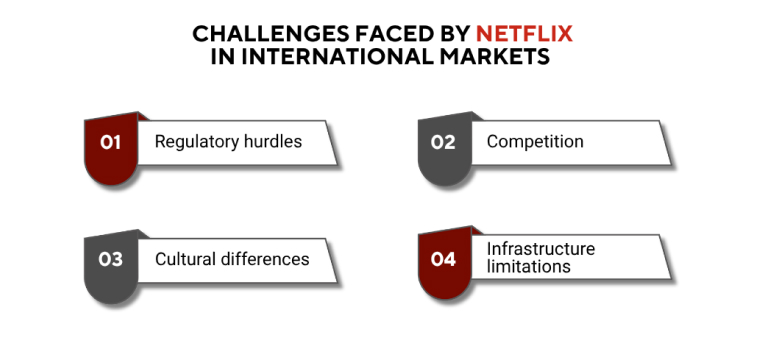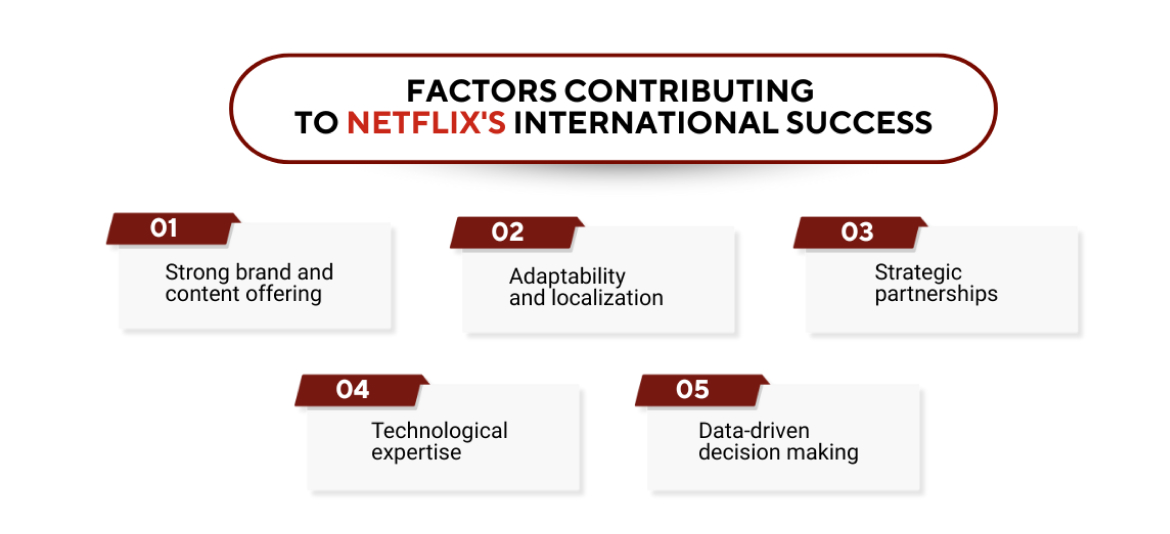Netflix, the world's leading streaming entertainment service, has experienced phenomenal growth and success on a global scale. From its humble beginnings as a DVD-by-mail service in the United States to its current position as a dominant player in the international streaming market, Netflix's journey is a fascinating case study in effective business strategy development. The company’s global expansion showcases the power of data-driven decisions, a concept Deevita Technologies applies in Power BI development to help businesses grow.
As of 2020, Netflix had 203.67 million subscribers worldwide, with over 73 million in the U.S. alone. By early 2022, this number grew to 222 million international subscribers across over 190 countries. This article delves into the key aspects of Netflix's international expansion, exploring the company's motivations, entry strategies, challenges faced, and the factors contributing to its success.
Netflix was founded in 1997 by Reed Hastings and Marc Randolph in Scotts Valley, California. Initially, the company operated as an online DVD rental service, offering a wide selection of titles and a convenient subscription model. However, as internet speeds improved and streaming technology advanced, Netflix recognized the potential of online video streaming and launched its streaming service in 2007.
The shift to streaming marked a significant turning point for Netflix, as it enabled the company to expand its reach beyond the United States. Netflix began its international expansion in 2010, starting with Canada, where it gained 1 million subscribers in less than a year—about 3% of Canada’s population. By 2014, 5.8 million Canadians (29% of English-speaking Canadians) were using Netflix. The global entertainment industry was ripe for disruption, with increasing demand for on-demand content and a growing preference for online streaming over traditional television. Netflix seized this opportunity, later expanding to Latin America in 2011, accessing a potential market of 600 million people, and by 2014, reaching 3 million subscribers in the UK, with one in ten households subscribed. In 2020, Netflix also saw success in Australia, where 12.2 million people had access, marking the second-highest penetration rate globally after Canada. However, content availability varied—while the U.S. had 10,625 unique titles in 2012, Canada had only 2,647, and Australian local content ranged from just 1.7% to 2.5% of the catalog between 2017 and 2019.
Netflix's decision to expand internationally was driven by several key factors. Firstly, the company recognized that its growth in the United States was slowing down, and international markets presented a significant opportunity for continued growth. By expanding globally, Netflix aimed to offset the financial impact of the slowdown in its home market and reach its target profits.
Secondly, Netflix understood that the entertainment industry was becoming increasingly globalized, with audiences around the world demanding access to a wide range of content. By expanding its service to new markets, Netflix could tap into this global demand and establish itself as a leading player in the international streaming market.
Lastly, international expansion allowed Netflix to spread its fixed costs over a larger subscriber base, enabling the company to invest more in content development and licensing. This, in turn, would help Netflix differentiate itself from competitors and attract more subscribers worldwide.
Netflix's international expansion strategy was characterized by a phased approach, with the company carefully selecting markets based on factors such as internet penetration, consumer preferences, and regulatory environment. The company's expansion can be divided into three key phases:
Phase 1 (2010-2015): Netflix began its international expansion in 2010 with its launch in Canada, followed by Latin America and the Caribbean in 2011, and Europe in 2012. During this phase, Netflix focused on establishing its presence in markets that were geographically and culturally close to the United States, allowing the company to gain valuable experience and refine its expansion strategy.
Phase 2 (2015-2017): In 2015, Netflix accelerated its global expansion, launching in Australia, New Zealand, Japan, and Singapore. The company also announced plans to expand to 130 new countries, including Russia, India, and South Korea. This aggressive expansion was driven by the need to stay ahead of the competition and establish Netflix as a global brand.
Phase 3 (2017-present): In 2017, Netflix completed its global expansion, making its service available in over 190 countries worldwide. The company has since focused on localizing its content and user experience to better serve the unique preferences of each market. This has involved investing in local content production, partnering with local telecommunications providers, and adapting its pricing and payment models to suit different markets.
Netflix has employed various entry modes and strategies to establish its presence in international markets. These include:
Netflix's primary entry mode in most international markets has been direct entry, which involves launching its streaming service under its own brand and utilizing its existing technology and content library. This approach allows Netflix to maintain a high degree of control over its operations, ensuring a consistent brand image and user experience across different countries.
By leveraging its existing resources and capabilities, Netflix can benefit from economies of scale, reducing the costs associated with content licensing, technology development, and marketing. This is particularly important in the streaming industry, where the ability to spread fixed costs across a large subscriber base is crucial for profitability.
However, direct entry also comes with its own set of challenges. Netflix must navigate complex regulatory environments, adapt to local consumer preferences, and compete with established local players in each market. To overcome these challenges, Netflix has invested heavily in understanding the unique characteristics of each market, tailoring its content offerings, and optimizing its streaming technology for different network conditions.
One of the key advantages of Netflix's direct entry approach is its ability to leverage data analytics to inform its content acquisition and production strategies. By analyzing viewer preferences and engagement patterns across different markets, Netflix can make data-driven decisions about which content to license, produce, or localize for each country. This helps the company optimize its content investments and maintain a competitive edge in the global streaming market.
While direct entry is Netflix's primary approach, the company has also formed strategic partnerships and collaborations in certain markets to navigate local regulations, gain access to valuable content, and expand its distribution reach. These partnerships have been particularly important in markets where local content is highly valued, or where regulatory barriers make direct entry more challenging.
One notable example is Netflix's partnership with Yoshimoto Kogyo in Japan, a leading entertainment conglomerate with a strong presence in the Japanese market, known for its production of popular TV shows, movies, and live events. By partnering with Yoshimoto Kogyo, Netflix gained access to a wealth of local content and expertise, allowing it to produce original series and movies tailored specifically to Japanese audiences.
This partnership has been crucial for Netflix's success in Japan, where local content is highly valued, and where competition from domestic streaming services like Hulu Japan and dTV is intense.
Netflix has also formed partnerships with local telecommunications providers and device manufacturers in various markets. These partnerships help Netflix expand its distribution reach, making its service available to a wider audience through bundled offerings or pre-installed apps on popular devices. For example, in India, Netflix has partnered with Airtel, one of the country's largest telecommunications providers, to offer its service as part of Airtel's mobile and broadband plans.
Such partnerships not only help Netflix reach more potential subscribers but also provide valuable insights into local market conditions and consumer preferences. By working closely with local partners, Netflix can better understand the unique challenges and opportunities in each market, allowing it to adapt its strategies and offerings accordingly.
Localization is a critical component of Netflix's international expansion strategy, as it helps the company cater to the unique preferences and cultural nuances of each market. By investing heavily in localizing its content and user experience, Netflix aims to make its service feel tailored to each country, increasing its appeal to local audiences and driving subscriber growth.
One of the key aspects of Netflix's localization efforts is dubbing and subtitling content in local languages. This is particularly important in markets where English proficiency is limited, or where viewers prefer to watch content in their native language. Netflix has invested in building a global network of localization teams and partners, ensuring that its content is accurately and effectively translated for each market.
In addition to language localization, Netflix also curates its content libraries based on local tastes and preferences. This involves analyzing viewer data and working with local content experts to identify the types of genres, themes, and storytelling styles that resonate with audiences in each country. By tailoring its content offerings to local preferences, Netflix can increase viewer engagement and satisfaction, leading to higher retention rates and word-of-mouth referrals.
Another important aspect of localization is adapting marketing and pricing strategies to suit different cultural and economic contexts. Netflix has demonstrated a keen understanding of the importance of culturally relevant marketing, creating local advertising campaigns and social media content that resonate with viewers in each market. The company has also experimented with different pricing models and subscription tiers to accommodate varying levels of purchasing power and willingness to pay across different countries.
For example, in India, Netflix introduced a mobile-only subscription plan at a lower price point to attract price-sensitive consumers and compete with local streaming services like Hotstar and Voot. This localized pricing strategy has helped Netflix gain a foothold in the highly competitive Indian market, where mobile devices are the primary means of accessing streaming content.
Netflix's localization efforts extend beyond content and pricing, also encompassing the user interface and payment methods. The company has adapted its user interface to support local languages and writing systems, ensuring that the platform is easy to navigate for users in each market. Additionally, Netflix has integrated local payment methods, such as mobile wallets and cash-based systems, to make its service more accessible and convenient for subscribers in different countries.
Despite its success, Netflix has faced several challenges in its international expansion:

Despite the challenges, Netflix has achieved remarkable success in its international expansion. Several key factors have contributed to this success:

Netflix's international expansion offers valuable lessons for companies seeking to develop and implement effective business strategies in the global marketplace. Key takeaways include:
Looking ahead, Netflix's international growth prospects remain strong, with significant opportunities in emerging markets and untapped audience segments. However, the company will need to continue innovating and adapting to stay ahead of the competition and navigate the evolving global streaming landscape.
As Netflix continues to invest in original content production, expand its global partnerships, and leverage its technological expertise, it is well-positioned to maintain its leadership in the international streaming market. By staying true to its core strengths and remaining agile in the face of new challenges, Netflix can continue to entertain and inspire audiences around the world for years to come.
Netflix's international expansion is a testament to the power of effective business strategy development in driving global growth and success. Through a combination of strategic planning, adaptability, and innovation, Netflix has transformed itself from a domestic DVD rental service to a global streaming giant, revolutionizing the entertainment industry in the process. As the company continues to evolve and expand, its journey offers valuable insights and inspiration for businesses seeking to thrive in the dynamic and competitive world of international business.

CredBadge™ is a proprietary, secure, digital badging platform that provides for seamless authentication and verification of credentials across digital media worldwide.
CredBadge™ powered credentials ensure that professionals can showcase and verify their qualifications and credentials across all digital platforms, and at any time, across the planet.

Keep yourself informed on the latest updates and information about business strategy by subscribing to our newsletter.